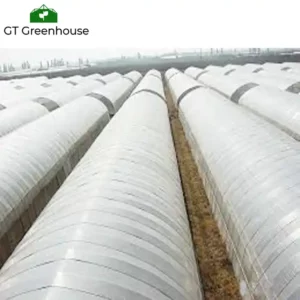Agricultural greenhouses have revolutionized the way we grow crops, offering a controlled and optimized environment for plants to thrive. These structures, also known as hothouses or glasshouses, provide a sheltered space that enables growers to extend growing seasons, enhance crop quality, and ensure year-round production. In this article, we explore the significance of agricultural greenhouses, their key features, and the transformative impact they have on modern farming practices.
The Purpose of Agricultural Greenhouses:
Agricultural greenhouses are enclosed structures designed to create a microclimate that is conducive to plant growth. These structures allow growers to manipulate environmental factors such as temperature, humidity, and light, providing an ideal setting for various crops. Whether used for small-scale horticulture or large-scale commercial farming, agricultural greenhouses offer numerous advantages in terms of crop yield, resource efficiency, and environmental sustainability.
Key Features of Agricultural Greenhouses:
- Structural Varieties:
Agricultural greenhouses come in various designs, including hoop houses, polytunnels, quonset huts, and traditional glass or plastic structures. The choice of structure depends on factors such as climate, crop type, and the grower’s specific requirements. - Climate Control Systems:
Greenhouses are equipped with climate control systems that allow growers to regulate temperature, humidity, and ventilation. Automated systems can adjust these parameters based on real-time data, ensuring optimal growing conditions for plants. - Covering Materials:
The covering material of agricultural greenhouses plays a crucial role in controlling light transmission and insulation. Common materials include polyethylene, polycarbonate, and glass. Each material has its advantages, ranging from cost-effectiveness to superior insulation properties. - Efficient Water Management:
Greenhouses enable efficient water management through irrigation systems such as drip irrigation or hydroponics. Water usage can be closely monitored and optimized, reducing waste and promoting sustainable farming practices. - Protection from External Elements:
The enclosed nature of agricultural greenhouses provides protection from external elements, including extreme weather conditions, pests, and diseases. This controlled environment minimizes the risk of crop damage, leading to higher yields and improved crop quality.
The Impact of Agricultural Greenhouses on Modern Farming Practices:
- Year-Round Cultivation:
One of the primary advantages of agricultural greenhouses is the ability to extend growing seasons. By providing a sheltered environment, greenhouses enable year-round cultivation, allowing farmers to produce crops even in adverse weather conditions or during off-seasons. - Increased Crop Yields:
The controlled environment within greenhouses promotes optimal conditions for plant growth, resulting in increased crop yields. Crops grown in greenhouses often exhibit faster growth rates, higher fruiting rates, and improved overall quality compared to traditional outdoor farming. - Resource Efficiency:
Greenhouses contribute to resource efficiency by minimizing water, fertilizer, and pesticide usage. The controlled environment allows for precise management of inputs, reducing waste and environmental impact. - Crop Diversification:
Greenhouses support crop diversification by providing a versatile environment for various plant species. Growers can cultivate a wide range of crops, including fruits, vegetables, flowers, and herbs, leading to diversified farm production and income streams. - Local Food Production:
Agricultural greenhouses play a crucial role in local food production. By enabling year-round cultivation, these structures support local farmers in providing fresh, seasonal produce to their communities, reducing the reliance on imported goods.
China’s Role in Advancing Agricultural Greenhouse Technology:
- Technological Advancements:
China has been at the forefront of incorporating technological advancements into greenhouse technology. Automated climate control systems, sensor-based irrigation, and precision farming technologies developed in China contribute to the efficiency and productivity of agricultural greenhouses. - Greenhouse Manufacturing Expertise:
China is a global leader in greenhouse manufacturing, producing a diverse range of structures to meet the needs of farmers worldwide. Chinese greenhouse manufacturers are known for their expertise in designing and constructing efficient and cost-effective greenhouse solutions. - Research and Development:
Continuous research and development in the field of greenhouse technology are evident in China. Collaborations between manufacturers, agricultural experts, and research institutions contribute to ongoing innovations in greenhouse design, materials, and functionality.
Considerations When Implementing Agricultural Greenhouses:
- Climate Considerations:
Choose a greenhouse structure and covering material that align with the local climate. Different structures and materials offer varying levels of insulation, light transmission, and durability, depending on the specific climatic conditions. - Crop Selection:
Consider the types of crops you intend to grow in the greenhouse. Different crops have distinct temperature, humidity, and light requirements, and the greenhouse design should cater to the needs of the chosen crops. - Budget and Resources:
Assess your budget and available resources for greenhouse installation and maintenance. While more advanced technologies may offer additional benefits, it’s essential to balance features with financial considerations. - Automation and Control Systems:
Evaluate the automation and control systems available for managing the greenhouse environment. Advanced systems can optimize climate control, irrigation, and nutrient delivery, improving overall efficiency and reducing manual labor requirements. - Local Regulations and Zoning:
Familiarize yourself with local regulations and zoning requirements for greenhouse construction. Compliance with building codes and environmental regulations is essential to ensure the lawful operation of agricultural greenhouses.
Agricultural greenhouses have transformed the landscape of modern farming, providing a controlled and efficient environment for plant cultivation. Whether used to extend growing seasons, increase crop yields, or promote sustainable farming practices, these structures play a pivotal role in shaping the future of agriculture. As technology and innovation continue to advance, agricultural greenhouses will likely remain at the forefront of efforts to meet the increasing global demand for fresh, high-quality produce.
